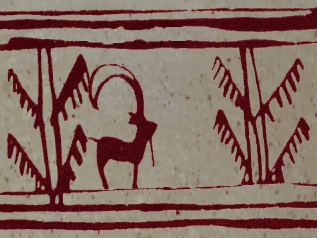اولین نقاشی متحرک تاریخ بر روی جام سفالی5000 ساله کشف شده در شهر سوخته
Burnt City's Ancient Animation
In Sistan va Baluchestan province, southeastern Iran
شهرسوخته با 150
هكتار وسعت در 55 كيلومترى زابل درحاشيه جاده زابل- زاهدان واقع و با قدمتی پنجهزار
ساله یکی از شگفتی های تاریخ ایران و بهشت باستان شناسان نامیده می شود.
كاوش در اين شهر باستانى از سال 1346 هجرى شمسى، توسط هيأت باستان شناسى از كشور
ايتاليا به سرپرستى« مورتيسيو توزى » آغاز شد و از سال 1353 تاكنون به سرپرستى دكتر
«منصور سجادى» ادامه يافته است.
سال هاى گذشته هفت فصل كاوش در اين شهر باستانى متعلق به سه هزارو 200 سال قبل
ازميلاد توسط باستان شناسان ومحققانى از ايران وايتاليا انجام شده است.
براساس آثار موجود ومكشوفه باستانى ، سرزمين سيستان و بخصوص شهر سوخته از گذشته هاى
دور داراى تمدن فرهنگى بسيار شكوفا بوده است.
The first world animated painting belonging to 5000 years ago along with 150 historical relics was on display from 28th of May 2007 in an exhibition under the title of 10,000 years Persian Culture and Civilization.
پنج هزار سال پیش در
«شهر سوخته»، هنرمندی ایرانی، روی جام سفالین طرح یك «بز» را ترسیم كرد. او در پنج
حركت، بزی را طراحی كرده كه به سمت درختی حركت و از برگ آن تغذیه میكند. اولین اثر
«تصویر متحرك»، یا انیمیشن که تا کنون در جهان، پیدا شده.
.
از این جام برای نوشیدن استفاده میشده است. ارتفاع این جام 10سانتیمتر و دهانه آن 8 سانتی متر قطر دارد و روی یك پایه استوار شده است.
This animation depicted a goat on an earthenware barrel in a position of jumping towards a bush to eat it.
This animated painting was discovered in Burnt City in Sistan va Baluchestan province, southeastern Iran.
تاکنون در دوره های پیش از تاریخ چنین تصاویری دیده نشده و برای اولین بار با این تصویر در شهر سوخته پیدا شده. در بسیاری از ظروف اشکالی را می بینیم که تنها تکرار شده اند اما حرکتی در آنها دیده نمی شود. اما تحقیقات نشان داد که این نقش، قدیمی ترین ایده هنرمنذان باستان برای ارائه تصویر متحرک و به تعبیر امروزی انیمیشن است.
It was the first time the animated goblet of Burnt City was on display, director
of Iran's National Museum said: In an attempt to choose a number of most unique
historical objects which have never been displayed before, the earthenware
animated goblet of the Burnt City has also been selected to put for public
display in this exhibition.
During their excavations in Burnt City in
1983,
Italian archaeologists found
a 5000- year-old goblet in
a grave with the design of a goat and a tree.
این جام در سال 1983 هنگام کاوش گروه باستانشناس ایتالیایی در یک گور بدست آمد. باستان شناسان پس از بررسی این سفالینه متوجه شدند که نقش تکراری آن برخلاف آثار دیگر بدست آمده از شهر سوخته هدف دارد بطوری که پس از پنج حرکت جهش بز بطرف درخت و تغذیه بز از برگهای آنرا نشان می دهد.
Further studies by archaeologists on this goblet revealed that there is a unique characteristic about this discovered goblet. What has made this one distinguished compared to the other ones unearthed so far is that the painting on this goblet has been repeated in a meaningful manner which shows:
The movement of a goat towards a bush during different positions. The artist who created this design used the goblet as his canvass to show the movement of the goat towards the tree for feeding itself in 5 movements.

با نزدیک کردن تصاویر به یکدیگر تصویر بز متحرکی را در قالب یک فیلم میبینیم.
Images of goat and fish are the most prominent designs works on earthenware
dishes which have been unearthed so far in Burnt City which was one of the most
civilized and developed civilization during ancient times. This painting shows
the movement of images in the shortest time on a goblet with an 8- centimetre
mouth.
On some other earthenware dishes which have been unearthed in Burnt City, a number of repeated images can be seen which do not move. From archaeologists point of view, people who lived in this city during ancient times were very clever, artist and well developed. This 10-centimetre goblet was placed on the top of a pillar and was used for drinking.
This animation and
the most ancient banner of Iran discovered in Shahdad,
a number of other unique historical relics ranging in date from the 7th
millennium BCE to the Qajar dynastic era (1787-1921) was on public display for
the first time. Some of these objects might have been probably go on display for
a while when they were discovered, however since they were displayed for a very
short period of time, a very few number of people had the chance to see them.
The exhibition of 10,000 years Persian Art and Civilization was
on February 2007, however, since the catalogue of the exhibition was not ready
and since the appropriate condition for holding the exhibition was not prepared,
the exhibition has been postponed.
![]()
World Association for American Studies انجمن های آمریکا شناسی در جهان
10 Most Successful Web 2.0 Startups to Date ده وب موفق از آغاز تا کنون
Top 40 ٍEnglish Sites بالا ترین چهل سایت انگلیسی زبان
Persian Bloggers in the World وبلاگ های ایرانیان در جهان
Keep us informed!!
![]()
Tell our Friends about
PersianCultureS.com
![]()
اگر مايل هستيد پرژن كالچرز را در صفحه لينک سايت خود قرار دهيد، می توانيد از نشان زير استفاده کنيد
You may use a thumbnail graphic of the PersianCultureS.com logo if you wish to create a link to the PersianCultureS.com website on your own page.
Add this site to your favorites